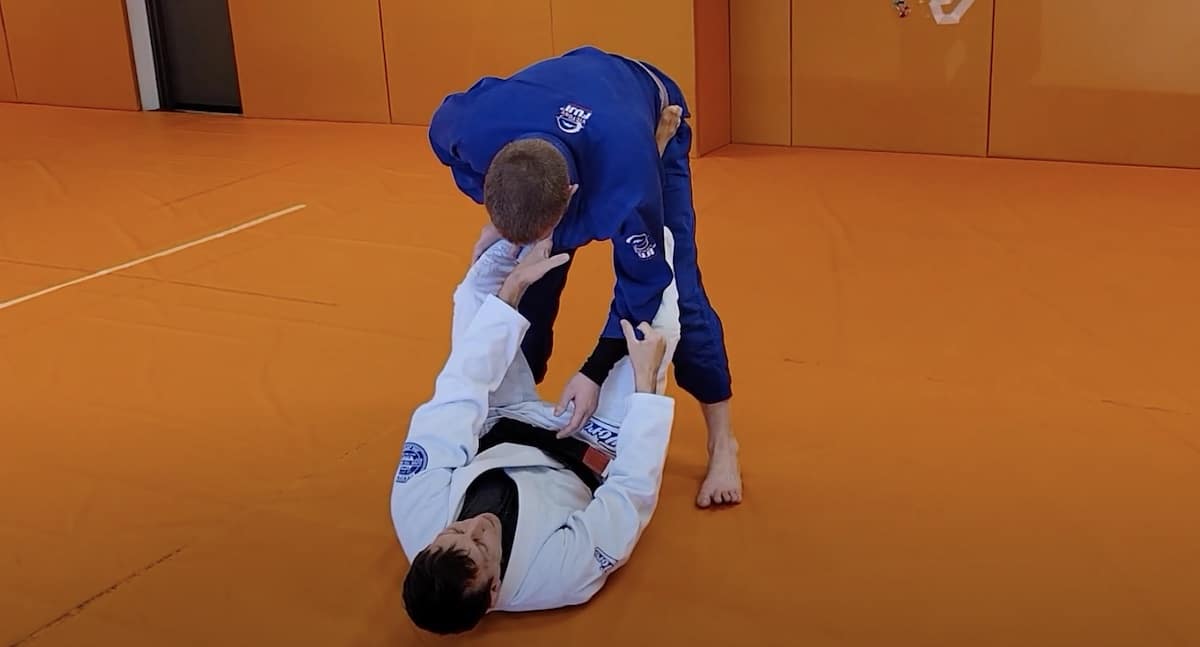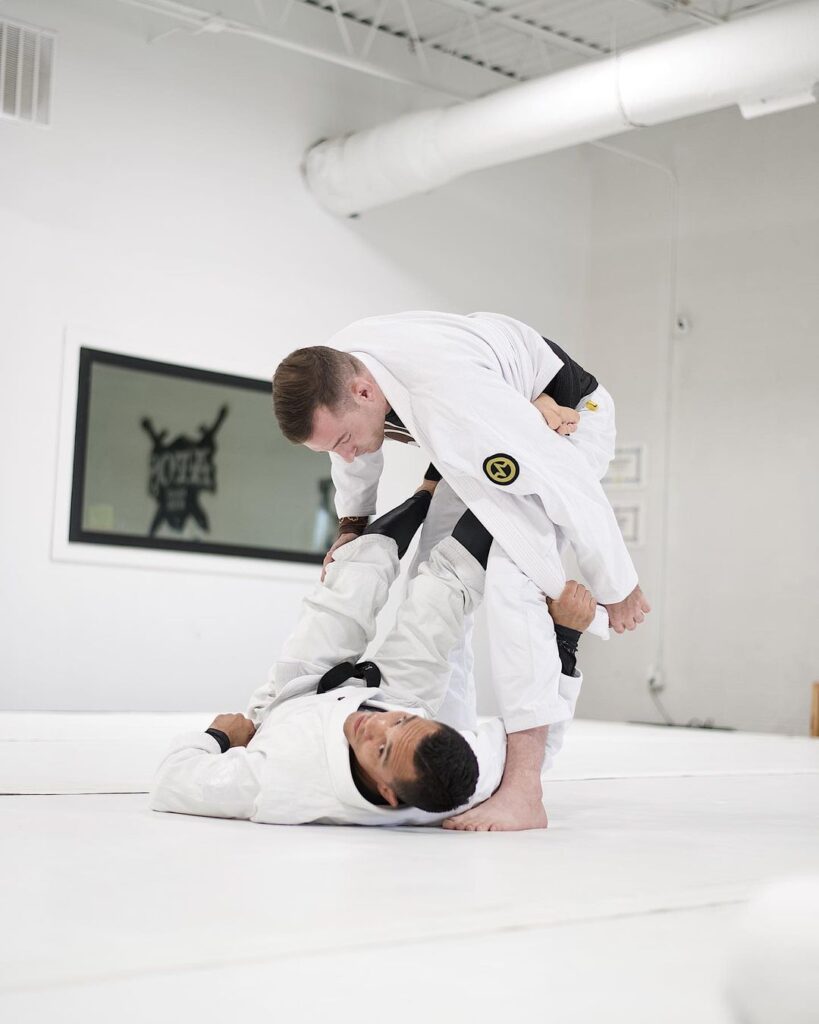Squid Guard – High Level BJJ Lapel Guard

Guards in BJJ have gotten highly technical, going from spider guard, lapel guard, worm guard, and now the squid guard. The squid guard is one of the newer and most high level guards in Jiu Jitsu.
Here is everything you need to know about the incredibly effective and innovative guard. We’ll go over everything from who created it, how to set it up, and tips for using this guard.

Who Invented The Squid Guard?
The squid guard came from the mind of Keenan Cornelius. One of the most innovative young minds in the world of Jiu Jitsu.
Keenan created the squid guard that evolved from his original guard which he calls the worm guard. He loves to use his opponent’s lapels against them to lace his feet and trap them.
This is the latest entry in his series of lapel guards that is growing. More guard players are now using the squid guard and we’ll definitely see similar techniques developed in the future.

How Does The Squid Guard Work?
Squid guard functions a little differently than the original worm guard. In normal worm guard/lapel guard variations, you take the opponent’s lap, and bring it across their body. Lacing it under their far leg to trap them in place and set up your attacks.
The squid guard variation was made to address the problem of the opponent taking their far leg away. So instead of lacing the far leg, you lace and trap the opponent’s near leg.
When you trap your opponent’s leg with your lapel it gives you control of their posture and leg. Opening the door for you to use a variety of different sweeps on your opponent.
Intro Into The Squid Guard
Since the squid guard is a more technical guard, you first have to learn how to get into the position.
A basic setup for the squid guard starts just like the worm guard. From on your back and your opponent standing, you need to pull out their lapel.
Keep one foot on your opponent’s hip, then cross grab their lapel, and pull it out. Traditionally with worm guard, you would reach for your opponent’s far leg and lace their lapel.
But a common defense that your opponent will do is step back and take this leg away. When they step back, their near leg is still next to you. This is the leg you use to set up squid guard.
You underhook your opponent’s leg with your free hand and pass their lapel over their knee to this hand. Now you have squid guard.
Squid Guard Options
Once you get into squid guard, you can hold the guard two different ways. The first way to hold squid guard is to face your opponent directly and play a style of open guard.
You can control their open side from anything from any type of spider guard control or a lasso guard control. A De La Riva hook on your opponent’s other leg is also another possible option.
The other option you have to hold squid guard is to go into an inverted style of guard. In this style of squid guard, you spin your body into your opponent and hug their knee to your chest.
Either option of squid guard control you decide to use will offer you a variety of different sweeps.
Inverted Squid Guard Sweeps
Inverting into your opponent when you have squid guard control gives you a wide variety of sweeping options. Here are just a few that you can choose from.
Pull & Push Options
Probably the easiest sweeps to do from this squid guard variation are the push and pull sweeps. When you invert into your opponent and pull their knee into your chest to fully control their leg.
Depending on your opponent’s reaction will determine which sweep you will use. If they keep their weight forward, pull your opponent over or push them if they keep their weight pack.
For the pull option, you’ll have to do it in one motion like a rolling kneebar. Invert, hug your opponent’s knee and roll them forward.
But if they keep their weight back, this opens the opportunity for you to use the push sweep. When you invert, and they lean back and straighten their leg, drive your weight into your opponent to knock them backwards.
Another option you have when your opponent leans their weight back is to grab their pants and pull them backwards.
Flower Sweep Variation
A common defense your opponent might do when they get put in squid guard is to back step over your head. When they do this, it puts them off balance and open for a flower sweep variation.
All you do to get this sweep is keep your control, kick your feet up for momentum, and sit up. When you complete this sweep, keep the lapel control, and go right into a stack pass. Just grab your opponent’s pants with your free hand to stack them and pass.
In this video, Keenan Cornelius breaks down how some of these sweeps work, while giving other pointers.
Other Squid Guard Attacks
Squid guard also offers a wide variety of submissions and other attacks. Here are a few other attacks that you can use with the guard.
Triangle Choke
A triangle choke set up is possible from the squid guard control. From the control, grab a same-side collar grip and put your free foot on the bicep of your opponent’s outside arm. Pull your opponent down to further break their posture and lock your triangle up.
Arm Lock
An easy arm lock is a great option from the squid control. You already have one side of your opponent’s body controlled, which opens up the attack. All you do is take sleeve control on the far arm, pull your opponent in, swivel your hips, and take the arm lock.
Omoplata
The omoplata is also available from squid control. For this set up, you’re going to put the omoplata on the same side of the leg you’re controlling.
You’re already under hooking your opponent’s leg, so just cross grab your opponent’s sleeve and go into the omoplata. The omoplata sweep options are also available for you.
Kneebar
The kneebar is another submission option for you available in squid guard. It comes off the same movement as the roll over sweep we previously detailed. You go through the same rolling motions, but you keep the leg and go for the kneebar.
If you want all the extra details on this submission, Andre Galvao breaks down everything about it in this video.
Important Tips
The squid guard is a highly technical guard that you must get all of the details perfect in order to attack. Here are the important tips you will need to remember.
- Lapel Control: Just like with the worm guard, you will need control of your opponent’s lapel. There is no squid guard without controlling your opponent’s lapel.
- Hook Front Leg: Remember in squid guard you hook your opponent’s front leg with their lapel. You hook their back leg when using worm guard.
- Lapel Over Knee: When you pass the lapel to your hand over hooking your opponent’s knee, cross the lapel above their knee. This breaks their posture and makes it harder for them to step out of the lapel control.
- Knee Placement: When you go into squid guard control, your knee has to be on the inside of your opponent’s knee. If you keep your knee on the outside, your opponent can freely turn into you.
- Foot Placement: Before you pass the lapel, remember that your foot needs to be placed on your opponent’s hip. This creates space and the lapel is supposed to cross over your foot when you pass it to your underhook hand.
- Open Guard or Inverted: Then finally, remember you can use squid guard in either an open guard or inverted style of guard. Each style provides you with different types of sweeps.






